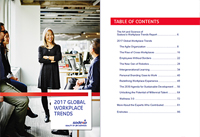Rethinking robotics: the possibilities are endless
Interview with Laurent Cousin, Group Senior Vice President Research & Development at Sodexo.
 Sodexo 2017 Global Workplace Trends Report is hot off the press with 10 major trends that will impact our workplace today and in the years to come. Today we sat down with Laurent Cousin, Group Senior Vice President Research & Development at Sodexo, to talk about how robotics is changing the way Sodexo does business.
Sodexo 2017 Global Workplace Trends Report is hot off the press with 10 major trends that will impact our workplace today and in the years to come. Today we sat down with Laurent Cousin, Group Senior Vice President Research & Development at Sodexo, to talk about how robotics is changing the way Sodexo does business.
Would you provide a brief background on what robotics means today?
Laurent Cousin: Sodexo has done quite a bit of research to qualify and define the term “robot.” It is important to clarify the different types of robots to avoid lumping them all into the same category. From our perspective, we identified four different categories of robots. First, robots used for observation – they measure, capture and transfer data and information. The second are the robots we classically see in the industrial sector – they perform industrial actions, transform and manipulate matter. The third type, service robots, execute tasks such as vacuuming, cutting grass, etc. And lastly, the robots that do not conduct physical tasks, but rather interact and communicate – whether through voice recognition, face identification, or interacting directly with end users. Of course, these categories are not strictly delimited, and there are many robots or robotized solutions belonging to more than just one category.
We also identified three generations of robots: repetitive, reactive and adaptive. The first generation, or repetitive robots, can repeat what they have been taught to do. Reactive robots capture data, recognize detail in external environments, and adjust their behavior accordingly. Their reaction is still based on a series of predefined algorithms, but the robot will make a decision based on the data collected, and react. The third generation, adaptive robots, represent a very large open field – a blue ocean of artificial intelligence where the robot learns from experience and builds new knowledge.
Can you tell us about Sodexo’s perspective on robotics, and what the Group is doing in this area?
L.C.: There are several key reasons why the use of robotics makes sense for us. Robots can help to improve productivity, quality and the regularity of the service, along with the delivery. They also ensure safety by helping us conduct some dangerous tasks without risk to human lives. And lastly, robots allow us to increase our sales offer – whether that means selling more in volume or value terms; developing our existing business, products and services; or developing something completely new - designing and offering a new service that was just impossible to deliver otherwise.
What aspects of robotics in the workplace are a cause for concern?
L.C.: If you think about robots, especially first or second generation robots that perform repetitive or reactive tasks, I clearly see there might be a risk of dehumanization. For example, if a human being provides a service, they are capable of noticing if a consumer is happier or sadder than usual and can adjust their behavior accordingly. At present, not many robots can do the same, even if face recognition is already improving... This is where we risk losing a big dimension of humanity – attention to human beings, capacity to customize, to specialize the service and enrich the services we perform.
That said, if we talk about the third generation of robots, those that are adaptive, those that have a so-called “intelligence,” then we can start to imagine situations where we won’t lose sight of this ‘’human” factor. The human factor is at the heart of what ultimately improves quality of life – which is not so much driven by just excellence in service delivery. This is where we want to remain very attentive. If the price to pay for robotization is to lose this human factor and attention to human beings, then I believe we should consider that price too high.
The media coverage we see regarding robotics in the workplace often runs the gamut – from excitement and innovation to doom and gloom about the effect on workers. What is your overall perspective?
L.C.: We see several economic analyses that try to measure the number of jobs that could be at risk because of robotics. I can understand how this can be threatening, but it won’t affect all jobs in any given industry, and even the jobs that will be affected will not completely disappear. Getting rid of painful, dangerous tasks is just the story of humanity, and positive progress. If there are components of a job that are painful, repetitive, or lack considerable added value, having a robot take over that part is a positive step forward. But we can’t be naïve – we must ensure that this transition is supported by the right training programs and service design, and that it is correctly managed and accompanied, in a meaningful manner.
Robotics, when done correctly, can eliminate painful and dangerous tasks, lower the risk for human beings and create opportunities for workers to transition to richer tasks and interactions. We don’t just want to chase after higher productivity. We know how rich our strategy can be: keeping the focus on Quality of Life for our employees, consumers and stakeholders can only end in being good for the whole of Sodexo.


